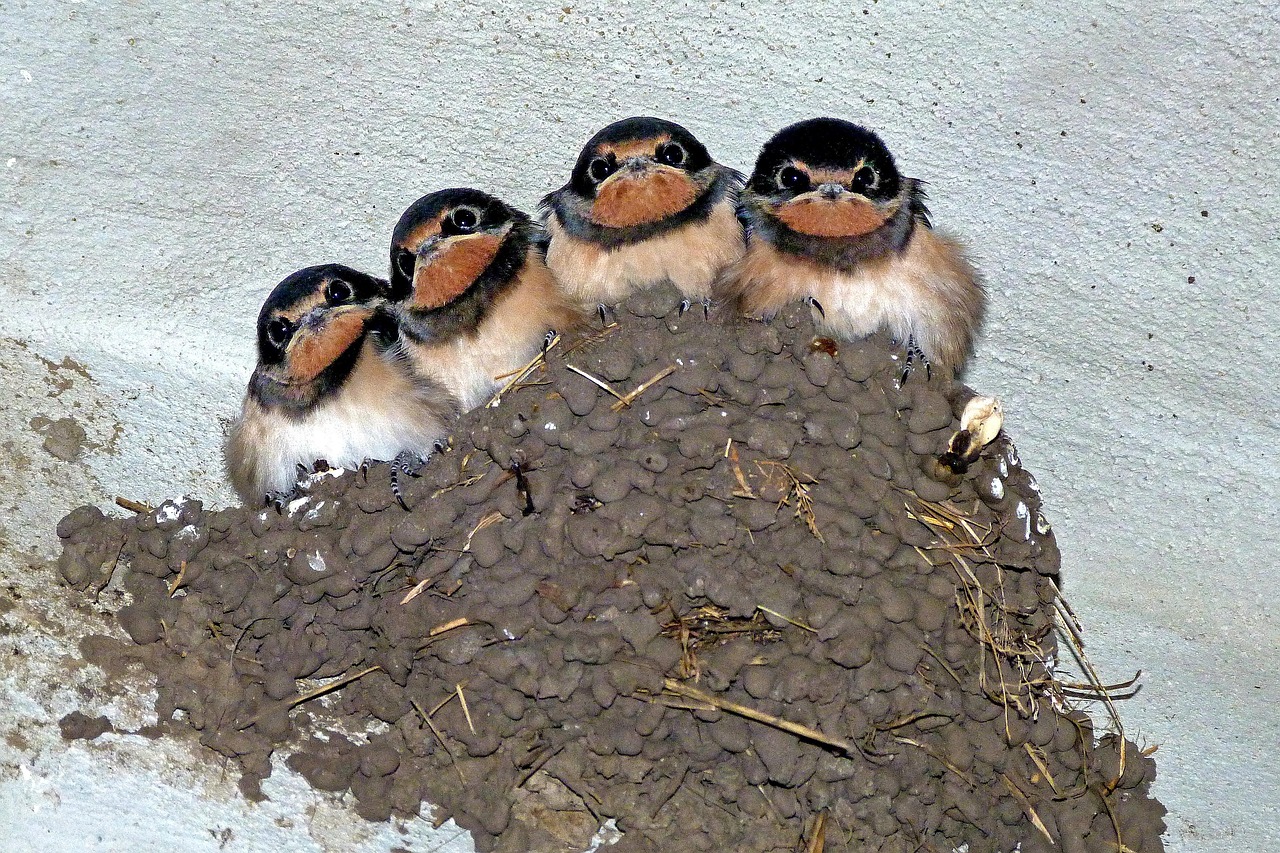Swallows are highly adaptable birds that have successfully integrated into human-made environments. Traditionally, they built their nests in natural locations such as cliffs and caves. However, with urbanization and the expansion of human settlements, swallows have learned to utilize buildings, bridges, and other structures as alternative nesting sites. This adaptation has allowed them to thrive in cities, towns, and rural areas alike.
The interaction between swallows and buildings is a fascinating example of how wildlife can adjust to human influence. While buildings offer protection and stability, they also introduce new challenges, such as limited nesting spaces and changes in food availability. Understanding how swallows navigate these environments provides valuable insight into urban ecology and bird conservation efforts.
The Relationship Between Swallows and Human Structures
Swallows have developed a unique relationship with human-made structures, relying on them for nesting, shelter, and even food sources. Historically, these birds nested in natural crevices, but as cities and rural settlements expanded, they found artificial structures to be suitable alternatives. Buildings, bridges, and barns provide the high vantage points and stable surfaces that swallows seek for their nests.
One key factor in this relationship is the availability of open eaves, ledges, and overhangs, which mimic the natural rock formations they originally used. Swallows also benefit from the presence of artificial light, which attracts insects—one of their primary food sources. Over time, their reliance on these structures has led to behavioural changes, such as nesting closer to human activity and adapting to different materials for nest construction.
Despite these benefits, swallows’ dependence on buildings comes with risks. Structural modifications, urban renovations, and the use of smooth surfaces can reduce suitable nesting spots. However, swallows continue to find ways to coexist with humans, making their presence a common sight in both urban and rural landscapes.
Why Swallows Choose Buildings for Nesting
Swallows prefer buildings for several reasons, many of which relate to survival and reproductive success:
- Elevated Nesting Sites – Swallows build their nests under eaves, on ledges, and within open barns, reducing the risk of ground predators.
- Protection from Weather – Unlike trees or exposed cliffs, buildings offer more stable conditions, shielding nests from heavy rain and strong winds.
- Access to Food – Many artificial structures are surrounded by open spaces, such as farmlands, parks, and water sources, where insects are abundant.
- Adaptability to Human Presence – Over time, swallows have become accustomed to living near people, recognizing that human activity can deter some natural predators.
By using buildings as nesting sites, swallows demonstrate their ability to adapt to a changing world. However, their long-term success depends on the availability of suitable structures and the willingness of humans to accommodate their presence.
Nesting Habits and Adaptations in Urban Areas
Swallows have shown remarkable adaptability in urban environments, modifying their nesting habits to take advantage of man-made structures. Unlike their ancestors, which built nests on rocky cliffs and inside caves, modern swallows often choose barns, bridges, and building eaves as their preferred nesting sites. These locations provide the necessary support and shelter for their delicate mud nests, protecting them from harsh weather conditions and predators.
Urban swallows have also adjusted their nesting materials based on availability. While they traditionally used mud mixed with grass and feathers, swallows in cities sometimes incorporate man-made materials like paper fibers and small debris into their nests. This flexibility allows them to build sturdy homes even in environments where natural resources are limited.
Another adaptation is their ability to tolerate human activity. Unlike other bird species that avoid urban areas, swallows have learned to thrive alongside people, often nesting in busy locations such as parking garages, train stations, and underpasses. Their ability to coexist with humans highlights their resilience and adaptability to rapidly changing environments.
How Swallows Modify Their Nesting Behavior in Cities
Swallows in urban environments display several behavioral adaptations that set them apart from their rural counterparts:
- Earlier Nesting Season – Cities often experience warmer temperatures due to the heat-island effect, leading swallows to begin nesting earlier than in rural areas.
- Reusing Nesting Sites – In urban areas, swallows frequently return to the same nesting locations each year, reducing the energy needed for nest-building.
- Increased Social Nesting – Swallows in cities sometimes build nests in close proximity to each other, benefiting from safety in numbers and shared vigilance against predators.
- Adaptation to Artificial Lighting – Streetlights and building illumination attract insects, providing a steady food source and influencing swallows’ hunting patterns.
These adaptations have allowed swallows to integrate successfully into cityscapes, demonstrating their ability to evolve alongside human development. However, rapid urbanization poses challenges, and the survival of urban swallow populations depends on maintaining suitable nesting environments.
Benefits of Buildings for Swallows
Human-made structures offer several advantages for swallows, making them ideal alternatives to natural nesting sites. Buildings provide elevated, sheltered locations that protect swallows from the elements and predators. Unlike trees, which can sway in strong winds, structures such as barns, bridges, and houses offer a stable foundation for their delicate mud nests.
Additionally, urban environments often create microhabitats that attract insects—swallows’ primary food source. Areas with streetlights, water sources, and open spaces tend to have higher insect activity, ensuring swallows have a consistent supply of food. This abundance of prey allows swallows to feed their chicks more efficiently, increasing their survival rates.
Another benefit is the protection from certain natural threats. While swallows in the wild face dangers from tree-climbing predators like snakes and raccoons, urban-nesting swallows often find safety in locations that are difficult for predators to access. This reduces nest predation, increasing their chances of successfully raising young.
Protection from Predators and Environmental Factors
Buildings serve as a safe haven for swallows in several ways:
- Elevation from Ground Predators – Nesting high on walls and eaves keeps swallows out of reach from predators like snakes, foxes, and cats.
- Shelter from Harsh Weather – Roof overhangs, bridges, and barns shield nests from heavy rain, strong winds, and extreme temperatures.
- Reduced Competition for Nesting Sites – Unlike trees, which may be occupied by other bird species or damaged by storms, buildings provide reliable structures that remain unchanged for years.
- Urban Heat Retention – The heat absorbed by buildings can provide warmth during colder months, helping swallows survive in cooler climates.
These benefits have allowed swallows to thrive in both urban and rural human-made environments. However, despite these advantages, modern developments pose new challenges that could impact their future survival.
Challenges Swallows Face in Human Environments
While buildings provide many advantages for swallows, urbanization and modern construction practices have introduced significant challenges. As cities expand and old structures are replaced with new materials, swallows face difficulties in finding suitable nesting sites. Many contemporary buildings have smooth, non-porous surfaces like glass and metal, which do not support mud nest adhesion. This limits their ability to build secure nests and forces them to search for alternative locations.
Another major challenge is the loss of open spaces. Swallows rely on open fields, wetlands, and meadows for hunting insects. However, increased urban development and land conversion for agriculture have reduced these natural feeding grounds, leading to food shortages in some areas. Pesticide use further exacerbates this issue by decreasing insect populations, making it harder for swallows to find enough food for their young.
In addition to habitat loss, swallows face threats from human activities. Many people remove nests from buildings due to concerns about droppings or aesthetics. In some regions, renovation projects and demolition can destroy active nesting sites, disrupting breeding cycles and reducing population numbers.
Impact of Modern Architecture on Swallow Populations
Modern construction trends have significantly altered the availability of nesting sites for swallows. Some key challenges include:
- Smooth Building Surfaces – Modern materials like glass, metal, and polished concrete make it difficult for swallows to attach their mud nests.
- Lack of Open Eaves and Ledges – Traditional wooden barns and older buildings provided ideal nesting spots, but newer designs prioritize sealed exteriors, limiting access for swallows.
- Increased Use of Pesticides – Urban and agricultural pesticide use reduces insect populations, leading to food shortages for insectivorous birds like swallows.
- Nest Removal by Property Owners – Many swallows face direct human interference when their nests are deliberately removed from structures.
Despite these challenges, swallows continue to adapt in creative ways. Some species have started using alternative nesting materials or shifting their breeding sites to locations where human disturbance is minimal. However, to ensure their long-term survival, conservation efforts and public awareness are essential.
Conservation Efforts and Human-Swallow Coexistence
As urbanization continues to reshape natural landscapes, conservation efforts have become essential to support swallow populations. While swallows have shown remarkable adaptability, they still face numerous challenges that threaten their nesting sites and food sources. Conservation initiatives focus on creating bird-friendly environments, protecting existing nesting sites, and raising public awareness about the importance of coexisting with swallows.
One of the most effective strategies is the installation of artificial nesting structures. In areas where traditional nesting sites have been lost due to modern architecture, conservationists and bird enthusiasts have successfully introduced nesting boxes and artificial ledges. These structures mimic natural nesting conditions and provide swallows with a safe place to breed.
Additionally, reducing pesticide use can help maintain healthy insect populations, ensuring swallows have a stable food supply. Encouraging organic farming practices and preserving open green spaces within urban areas can further support swallow survival.
How People Can Support Swallows in Urban Spaces
Individuals and communities can take several steps to promote the coexistence of swallows in urban areas:
- Preserve Existing Nests – Avoid removing swallow nests from buildings, especially during the breeding season, to allow young birds to develop safely.
- Provide Artificial Nesting Sites – Installing mud platforms, nesting boxes, or wooden ledges can offer alternative nesting locations in areas where traditional sites are unavailable.
- Reduce Pesticide Use – Encouraging natural pest control methods helps maintain insect populations, ensuring swallows have enough food.
- Support Habitat Conservation – Protecting wetlands, open fields, and water sources near urban areas provides essential foraging grounds for swallows.
- Educate Communities – Raising awareness about the ecological benefits of swallows, such as their role in controlling insect populations, can foster greater appreciation and conservation efforts.
By taking these steps, individuals can contribute to a swallow-friendly environment, ensuring these birds continue to thrive alongside human development. Promoting a balance between urban growth and wildlife conservation is key to maintaining healthy and diverse ecosystems.
Conclusion
Swallows have demonstrated remarkable adaptability in integrating into human environments, using buildings and structures as nesting sites. While urbanization has provided them with stable shelter, protection from predators, and abundant food sources, it has also introduced challenges such as habitat loss, modern architectural barriers, and reduced insect populations.
Despite these obstacles, swallows continue to thrive through their ability to modify nesting behaviors and coexist with humans. However, their long-term survival depends on conservation efforts and public awareness. By preserving nesting sites, reducing pesticide use, and creating swallow-friendly environments, individuals and communities can help support these fascinating birds.
As cities continue to expand, it is crucial to find a balance between urban development and wildlife conservation. Encouraging human-swallow coexistence not only benefits swallows but also contributes to the health of ecosystems by maintaining natural insect control. With thoughtful conservation measures, swallows can continue to be a familiar and cherished presence in human environments for generations to come.

